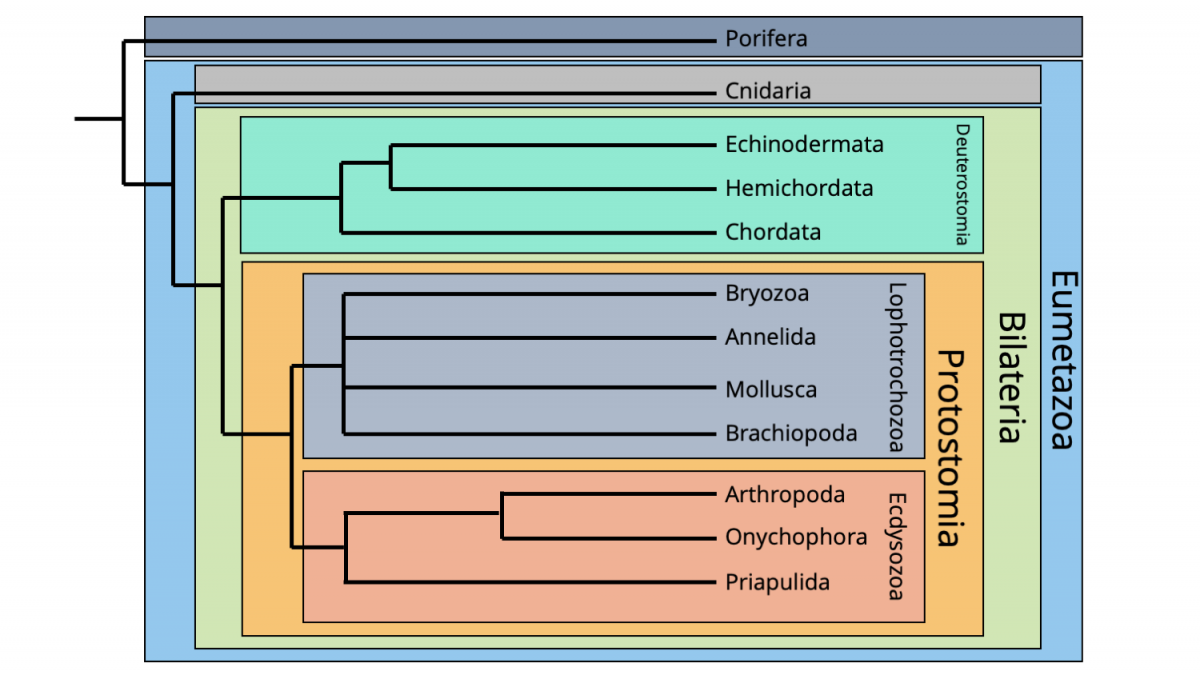Molecular Evidence for Insect Ancestral Phylogeny Is Best Described as
Phylogenetic analysis of InR sequences in key animal phyla revealed that the ancestral InR duplication leading to the presence of two InR genes in most insect taxa took place at earliest in a late hexapod ancestor of Insecta or within basal Insecta as recently suggested by Kremer et al. Nucleic acid and protein analyses have greatly informed the modern phylogenetic animal tree.
Determining Evolutionary Relationships Boundless Biology
Terebrantia includes one very speciose family Thripidae plus the smaller Aeolothripidae Heterothripidae and Melanthripidae and four even smaller families.

. Detailed analysis of 98 insects from 23 orders showed the presence of only Cluster I. In the traditional phylogeny A the phylum Platyhelminthes is depicted as a sister taxon to the rest of the protostome phyla and as having diverged earlier from the lineage that led to the rest of the protostomes. Morphological and molecular evidence converge upon a robust phylogeny of the megadiverse Holometabola.
Evidence of common descent. Advances in Insect Phylogeny at the Dawn of the Postgenomic Era Annu. Describes a characteristic on a phylogenetic tree that is shared by all organisms on the tree.
These data come from a variety of molecular sources such as mitochondrial DNA nuclear DNA ribosomal RNA rRNA and certain cellular proteins. Many evolutionary relationships in the modern tree have only recently been determined due to molecular evidence. Technique using molecular evidence to identify phylogenetic relationships.
Two competing hypotheses to account for the increase in the number of Hox genes from the last common ancestor all bilaterians to the last common ancestor of insects and vertebrates are. A combined effort and a strong synergy effect between the research groups finally resulted in the largest and arguably best documented morphological data set ever used in insect systematics. Evolutionary relationships between animal phyla or Metazoa are based on the the presence or absence of differentiated.
Scientists have hypothesized that the common ancestors of birds and mammals possessed three-chambered hearts two atria one ventricle. Molecular biology insect morphology paleontology insect taxonomy evolution embryology bioinformatics and scientific computing. In this postgenomic era insect systematics will be furthered best by integrative methods aimed at hypothesis corroboration from molecular morphological and paleontological evidence.
A recent reanalysis of molecular evidence by an international group of evolutionary biologists refuted the proposition that comb jellies are the phylogenetically oldest extant metazoan group. This was the first phylogenetic evaluation of extant and living insect lineagesWhen reconstructing evolutionary relationships among insects authors have argued that fossils provide vital information about character polarity eg. Friend A states that systematics and phylogenies are really the same one is more recent than the other but basically they are the same.
Molecular evidence supports one of the traditional morphological divisions of the Thysanoptera into two suborders Tubulifera containing the sole speciose family Phlaeothripidae and Terebrantia. The most recent understanding of the evolution of insects is based on studies of the following branches of science. Friend B says that systematics is the same as cladistics and cladistics is reconstructing clades which ultimately lead to.
Hennig 37 38 incorporated fossils in a phylogenetic treatment of insects based on morphological synapomorphies Figure 2a. From a molecular point of view the mitochondrial COI gene used for DNA barcoding has been considered to be an effective tool for the discrimination of species level. Evidence of common descent of living organisms has been discovered by scientists researching in a variety of disciplines over many decades demonstrating that all life on Earth comes from a single ancestor.
Phylogenetic trees are constructed using various data derived from studies on homologous traits analagous traits and molecular evidence that can be used to establish relationships using polymeric molecules DNA RNA and proteins. Describes a characteristic on a phylogenetic tree that is shared by all organisms on the tree. These data come from a variety of molecular sources such as mitochondrial DNA nuclear DNA ribosomal RNA rRNA and certain cellular proteins.
Considering the convincing molecular evidence and the unambiguous support by our extensive morphological data set the monophyly of Coleopterida. Phylogeny of the holometabolous insect orders. In the molecular phylogeny B Platyhelminthes is depicted as a lophotrochozoan phylum.
Wiegmann1 Rolf Beutel2 Karl M. Monophyletic group also clade organisms that share a single ancestor. Nucleic acid and protein analyses have greatly informed the modern phylogenetic animal tree.
We used a comprehensive sample of the diversity of this group involving 193 genome-scale datasets and sequences from 2395 genes to uncover the evolutionary tree for these insects and provide a timescale for their diversification. Hemipteroid insects constitute a major fraction of insect diversity comprising three orders and over 120000 described species. Birds and mammals however are alike in having four-chambered hearts two atria two ventricles.
1 a single duplication of the entire 4-gene cluster followed by the loss of one gene and 2 3 independent duplications of individual Hox genes. This forms an important part of the evidence on which evolutionary theory rests demonstrates that evolution. It is estimated that the class of insects originated on Earth about 480 million years ago in the Ordovician at about the same.
The study which relied on more sophisticated methods of analyzing the original genetic data reaffirms the traditional view that the sponges were indeed the first phylum to diverge from the. Single ancestral lineage on a phylogenetic tree to which all organisms. Kjer3 and David K.
Which of the following statements best describes the four-chambered hearts of birds and mammals. Many evolutionary relationships in the modern tree have only recently been determined due to molecular evidence. Zoologica Scripta 31 315.

Organizing Life On Earth Concepts Of Biology

Animal Phylogeny Digital Atlas Of Ancient Life


No comments for "Molecular Evidence for Insect Ancestral Phylogeny Is Best Described as"
Post a Comment